 |
 |
 |
 |
 |
Follow this timeline to explore four centuries of experimentation
in perspective theory and spatial illusion. Click images in the timeline for more.
|
 |
 |

|
 |

|
 |
|
1435
Leon Battista Alberti composes the De pictura (On Painting),
the first text to define and theorize linear perspective.
|
 |
  What is Alberti's visual pyramid?
What is Alberti's visual pyramid?
What is linear perspective?
|

|
 |
Late 1400s
The artist Paolo Uccello devotes so much time to his "mistress"
perspective, that his wife is reported to have become jealous.
|
|
1525
German artist Albrecht Dürer brings the science of perspective to Northern Europe
through his illustrated treatise Unterweisung der Messung.
|
 |

|
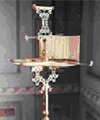
|
 |
1557
The 16th century sees the development of complex perspective machines,
like this one by Baldassarre Lanci.
|
|
1568
Illusionistic ceilings, like this one, probably for the Church of San
Pietro al Po near Cremona in Northern Italy, enjoy a vogue from the 16th
through 18th centuries. They seem to extend the space of the church
beyond the ceiling.
|
 |

|
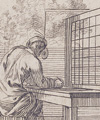
|
 |
1649
A scandal erupts in France when Jean Dubreuil is accused by his
colleague Girard Desargues of plagiarizing his theories and
committing "enormous mistakes and falsehoods."
|
|
1700s
The production of miniature paper theaters brings three-dimensional,
illusionistic entertainment into middle-class homes.
|
 |
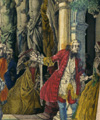
|
|
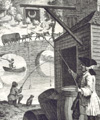  Where has the perspective gone awry?
Where has the perspective gone awry?
|
 |
1755
With a series of visual puns, Hogarth describes the many possible mistakes
that the painter may make when disregarding the application of perspective.
|
|
1798
Descriptive geometry, pioneered by Gaspard Monge, comes into its own as
a scientific application of perspective projections distinct from
artistic applications.
|
 |
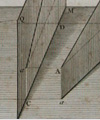
|
|
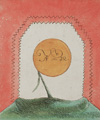  What is anamorphosis?
What is anamorphosis?
|
 |
1775-1800
With irregular perspective already the fashion among artists and theorists,
anamorphosis reaches its apex as a popular curiosity, with people of all social
classes delighting in the bizarre and the marvelous.
|
|
Early 1800s
Andrea Pozzos 17th-century treatise still poses challenges to artists
like Elie-Honoré Montagny, who quipped on this sheet that Pozzo
"demands great application in the correct execution of this exercise, which
is a very difficult one."
|
 |
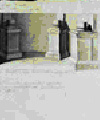  Compare this to its model.
Compare this to its model.
|
|
|
 |
|










